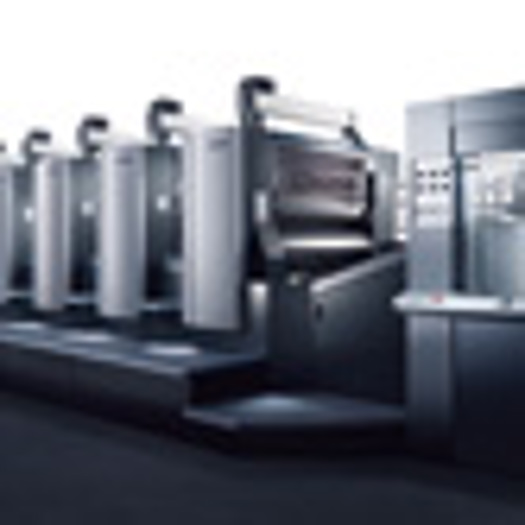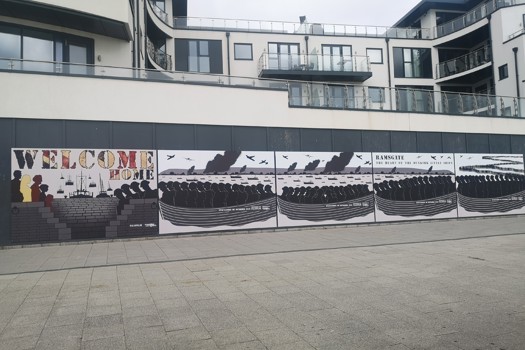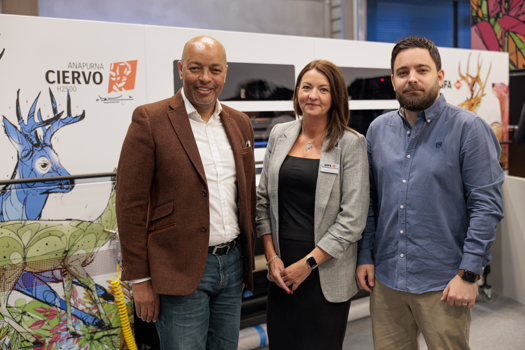Just when it looked as though Ipex was going to be bereft of any conventional offset press launches - historically the show's bread and butter - Heidelberg (and Komori to be fair, see p11) have come forward with some armour ready to shimmer in the Birmingham sun.
The German giant's latest offering, the Speedmaster CX 102, may be a hybrid of what it says is the world's best selling B1 platform, the CD 102, and the XL 105, but it's no cut ‘n' shut job bolted together in a backstreet Wiesloch garage. It's a serious press, with serious aspirations and, according to Heidelberg, bristling with serious innovations.
There's no denying that the 16,500 sheets per hour (sph) CX 102 is heavily based on the CD 102, handling the same formats and also the same substrate thicknesses, up to 1mm - and like its forebear, it will not be available as a perfector. But it's not just a pimped up CD. According to Heidelberg, around 50% of the components on the press are either new or borrowed from the XL 105.
The firm believes the press, which sits squarely between the CD and XL in every respect, offers the best of both worlds, but costs 10-15% less than a similarly equipped XL.
Target market
"Nobody who is running an XL will go back to a CX. However, those who are not ready for the step up to, or cannot afford an XL, but want to benefit from the technologies of the XL without needing the speed, then the CX is the perfect press," says Jürgen Grimm, Heidelberg senior vice president product management.
According to Grimm, users are likely to be 80% commercial and 20% packaging worldwide, but Gernot Keller, Heidelberg UK B1 product manager, believes the split in the UK, with our love of long perfectors in the commercial arena, will probably be nearer 50/50. However, both men agree that what the packaging and commercial users will have in common is a need for flexibility and productivity.
So let's start with the basics: the side frames. The CD 102 was a 15,000sph-rated press and the frame was never going to be able to handle 16,500sph day in day out. So when Heidelberg began work on the project four years ago, they cast new, heavier side and inking frames - 200kg heavier per unit to be precise. These feature additional and reinforced spreader bars in the inking frame to cope with the higher speed of the oscillating rollers in the inking train. The plate cylinder bearing casing is fully integrated into the new side frame and completely separate from the inking unit, whereas on the CD it's encased between the upper and lower frames.
Borrowed features
As well as the same plate size, the press uses the same double-sized impression cylinders as the CD, as well as the triple-sized skeleton transfer drum that features the proven Venturi Air Transfer technology. The inking and dampening unit is also inherited from the CD, meaning it's capable of running reduced or alcohol free and features the firm's Alcolor Vario dampening technology. Equally, the press comes with the CD's Zero Oscillation feature, so if the press stops, for example for a pile change or wash-up, provided you keep the press idling the colour profile is maintained.
The CX's feeder and delivery units are lifted directly from the XL. The Preset Plus Feeder and Preset Plus Delivery are both designed to handle the XL's 18,000sph, so 16,500sph, according to Heidelberg product manager Rainer Wolf, is a walk in the park. The feeder features automatic format and air settings, as well as speed compensation.
The faster the press, the more critical dynamic sheet control and stability becomes in the transport - so with this in mind, Heidelberg has lifted and developed a number of other XL technologies. Foremost is the taper rolling bearing units used on the sheet travel and plate cylinders.
Wolf admits not many people get over excited about bearings, but as he says "15 years ago, a typical press would be printing 15m sheets a year, today its nearer 30m and with the CX it can be nearer 50m - so you need these developments".
Equally, the CX uses the same grippers as the XL, with wider diameter shafts and fewer lubrication points. The Preset Delivery Plus also features Heidelberg's patented ‘vented' gripper bars that maintain a constant airflow over the sheet at high speeds - making the sheet aerodynamically stable and, importantly, helping to ensure an even spread
of powder.
While technically the synchronised PowderStar AP 500 system, which enables the press to comfortably run the powder as low as 10% on many jobs at full speed, is an option on conventional non-UV CXs, it will be standard in reality.
The vented grippers also aid drying by enabling the dryer to be closer to the sheet, which exponentially improves performance, whether it's hot air or IR. The final piece of the highly automated delivery jigsaw is the dynamic sheet brake option, which eliminates marking on even super light and label stocks by speeding up to receive the sheet, before slowing it down and depositing it on the pile.
Range of options
Plate changing is semi-automatic as standard or upgradeable to fully automatic, but the XL option of simultaneous plate changing is not available on the CX, simply because the cost of adding the declutching system would increase the cost of the machine substantially - it's the same story for the automatic non-stop delivery to be launched for the XL at Ipex.
But there are a whole raft of options available on the CX, arguably too many to list. Coating is a given, but it can also be configured as a double coater or Duo machine, with flexo and curing units before and between the litho units. Other add-ons include interdeck drying, Intellistart for faster
makereadies, Prinect Press Centre, Axis Control and
Image Control.
However, according to Heidelberg UK's Keller, the critical option for many users will be the Prinect Inpress Control inline closed-loop colour management system.
XL-born options including CleanStar, CoatingStar, FoilStar inline cold-foiler, InkStar, StaticStar and DryStar monitoring system are available, as are energy reduction features such as AirStar and CombiStar. The press can even be delivered carbon neutral, with Heidelberg offsetting all of the carbon generated in its manufacture.
The CX isn't a replacement for the CD - the firm says it simply plugs the gap between the CD and the XL. However, Grimm admits that in the industrialised markets like the UK, the CX and XL will be the core models.
Equally, Grimm fully expects rivals to dismiss the press as just a CD/XL hybrid, rather than a truly new press, but he argues that if that's true then with the exception of Heidel-berg's XL series, there have been no ‘new' presses from the any of the heavy metal manufacturers for the past 20 years.
"Is it a new product? At the end of the day, we say it is a new product, we have nothing to hide. It is a CD platform, but I'm happy to discuss that with anyone - we know it's a new model and I think our customers will to," says Grimm.
SPECIFICATIONS
Max speed 16,500sph
Max number of units 8
Max sheet size 720x1,020mm
Min sheet size 340x480mm
Max stock thickness 1mm
Price around £1.3m (five-colour plus coater, not including Inpress)
Contact Heidelberg UK 0844 892 2010 www.uk.heidelberg.com
THE ALTERNATIVES
KBA Rapida 106
The Rapida 106 is a larger-format press and also faster, but it's the KBA model that Heidelberg has set its sights on. However, KBA will probably see the Rapida 105 (15,000sph and £1.1m for five-colour plus coater) as a fairer comparison. The 106 comes with the options of simultaneous plate changing (SPC) and perfecting, but the 105 doesn't.
Max speed 18,000sph
Max number of units 16
Max sheet size 740x1,060mm
Min sheet size 340x480mm
Max stock thickness 0.7mm (1.2/1.6mm options)
Price from £1.4m (five colour plus coater including SPC)
Contact KBA 01923 819922 www.kba-print.co.uk
Komori Lithrone SX40
Heidelberg sees Komori's Drupa-launched flagship B1 press, the SX40, as the main competitor to the CX. As with the 106, it's faster and slightly longer but, unlike the CX, fully automatic plate change comes as standard.
Max speed 18,000sph
Max number of colours 10
Max sheet size 750x1,050mm
Min sheet size 360x520mm
Max stock thickness 1mm
Price from £1.3m (five colour plus coater)
Contact Komori UK 01132 799900 www.komori.com
Manroland 700 DirectDrive
It may be more expensive then its rivals, but it does come with fully automatic simultaneous plate changing as standard, and a high level of automation is its raison d'être. Perfecting is also an option.
Max speed 16,000sph (17,000sph option)
Max number of units 12
Max sheet size 720x1,040mm
Min sheet size 340x480mm
Max stock thickness 1mm
Price from £1.7m (five-colour plus coater)
Contact Manroland GB 020 8648 7090 www.manroland.co.uk









